If you’re looking for a viable business model, online (eCommerce) stores are a very popular option. For new business owners who want to get their hands dirty, they may bring some great benefits, so to speak, and sell their goods to a large audience.
That’s why we’re comparing the top 10 of the market’s most successful and best e-commerce and online store solutions today.
From price tables, functionality, architecture, ease-of-use, to hosting problems, pros and cons of each platform, target audience, number of product attributes allowed, marketing optimization, and more, we have analyzed every important aspect that will help you grow a business in the eCommerce room …
We hope that this will ultimately become your “complete guide” to getting started with eCommerce and choosing between these six options: Wix, Shopify, Magento, WooCommerce, BigCommerce, Jimdo, 3dcart, Squarespace, Weebly, Volusion, Magento, and Prestashop.










It can be very difficult to say how seemingly insignificant variations in functionality and results can have a significant effect on your bottom line when you look at e-commerce apps, but they can.
Both suppliers say they are quicker, more efficient, better suited to leveraging the search engine, PCI ready for credit cards, etc. than the competition. But what is that reality?
The last thing I want is for you to configure your website for e-commerce and just load your items to make it run super slow. Or find out that to sync your inventory with Amazon and dropship items, you need to pay an extra $399 a month.
We decided to use real site data to compare the functionality, performance, ease of use, design & themes and integrations of the top e-commerce platforms. In order to conquer your niche, you can learn which platform fits your needs, performs the best, and gives you value.
Our Analysis And Research Methods
You have to run a number of checks and have a structured process of reviewing platforms for online retailers if you want real results. I have just included the most popular channels. Smaller, niche corporations like the Large Cartel didn’t have me.
This is a short description of how our findings were obtained:
Choosing places critically from each website
- To find the 10 most common e-commerce platforms, we used BuiltWith
- We built a filter to identify successful e-commerce sites that invest at least $500 per month operating on each website. This is a crucial important contrast between the initial research. We did not do this in the original report, and it made an incorrect distinction. In contrast to Shopify, you can set up WooCommerce to be super cheap. If you pay for Shopify on a monthly basis, you’re more apt to want to sell the site. So, under advertised (dead sites) the previous studies covered.
- With all the websites on each network, we pulled a huge spreadsheet (ex. our Magento list had 5K+ sites)
- The RAND feature used in Google Sheets to give each row a random number
- Data obtained for each channel for the first 100 websites (100 pages x 10 platforms = 1000 sites)
Data Analysis On 1,000 Places We Studied:
Using a team of 4 researchers to gather data for each website (myself included)
- Time for loading from Pingdom
- Web PageSpeed, Mobile UX and User Friendliness Utilizing Link Profiler From Google
- Rating Details From Ahrefs
Converting Raw Points into Significant Ratings
In our study, in an average of meaning, features, efficiency, ease of use, design & themes, and integrations, we calculated total scores.
- Quality scores are focused on the load time of the storefront website, Google pace, SEO characteristics, and rating.
- Features are focused on providing marketing characteristics that are must-have and cool. Features were scored higher if free and lower if add-ons were charged if they were provided.
- Ease of use is focused on friendliness for newcomers, help accessible, engagement by partners / community, apps / plugins and their scores, accredited partners / community base, and friendliness for developers.
- Integration explores the potential to distribute across various platforms (e.g. Amazon), compliance of other business structures (dropshipping) and integration with other content automation. When the online company expands, much of this is about scalability.
- Availability & amount of free themes, web design ranking, Google mobile UX score, user friendliness, and cost of premium themes are dependent on design and theme ratings.
BigCommerce
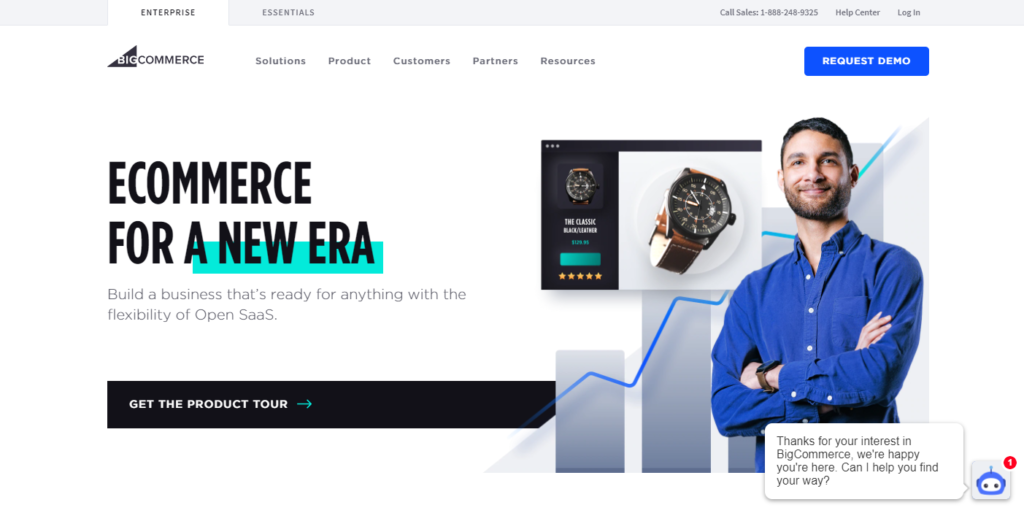
BigCommerce is the strongest e-commerce site overall. For larger supermarket brands, the robust commodity search engine renders it perfect. For individuals who wish to establish an e-commerce store, or who have a brick and mortar store and want to extend their activities to include internet purchases, it is also a smart option. The resources available make it possible to be competitive in every niche or sector.

By using some of the customized models to build your store, sell and advertise your items, the app helps you to configure your online shop without needing to know how to code. It is targeted at anyone lacking too much web dev abilities, but it still enables HTML and CSS to be modified by tech-savvy individuals.

I love BigCommerce themes; in the store you can see sophisticated and buyer-centric models, but only a few are free. Two of variants of them, allowing a total of seven free themes, to be specific.
There’s a large group of designers and creators on the fly-side. The list of collaborators lets you locate specialists with an extra side.
As for pricing, it costs 29.95 / month for the lowest package. Any treats are going along, such as checkout codes, gift vouchers, unrestricted bandwidth, and competent news. You don’t get a custom SSL or discarded cart saver, though, so it’s always pretty useful for basic shops not having more than 50k per year worth of revenue. If the schedule moves higher, so does the cap for purchases.
Pros
- Scalable and versatile
- Excels for the sale of multi-channel
- High Performance of SEO
- Terrific Theme Concepts
- Comprehensive role of discarded cart
Cons
- In consecutive tests, inconsistent speeds
- Getting costly for high-volume retailers
- The abandonment of carts is not on the entrance plan.
- No 1-Click Selling / Upsells
Shopify

The strongest app for purchases is Shopify. Depend on Facebook Advertising or Instagram marketing if you intend to lower ship. This is the safest option. If I had to focus on SEO, I wouldn’t use Shopify. If I wanted to build a big store with several items, I would not use Shopify either. I will instead use BigCommerce.
In some ways, Shopify is marginally better than BigCommerce, such as post-purchase 1-click upsells, but far behind in terms of results. I’ve already used Shopify on my platform and have collaborated with several Shopify sites in the past, but I prefer WordPress more because, in addition to goods, I have an affiliate revenue model.

With Shopify ‘s drag and drop gui, it’s simple to set up an online store. Many website production rookies will get the feel of it in a couple of minutes.
Their submissions are much too many to mention.
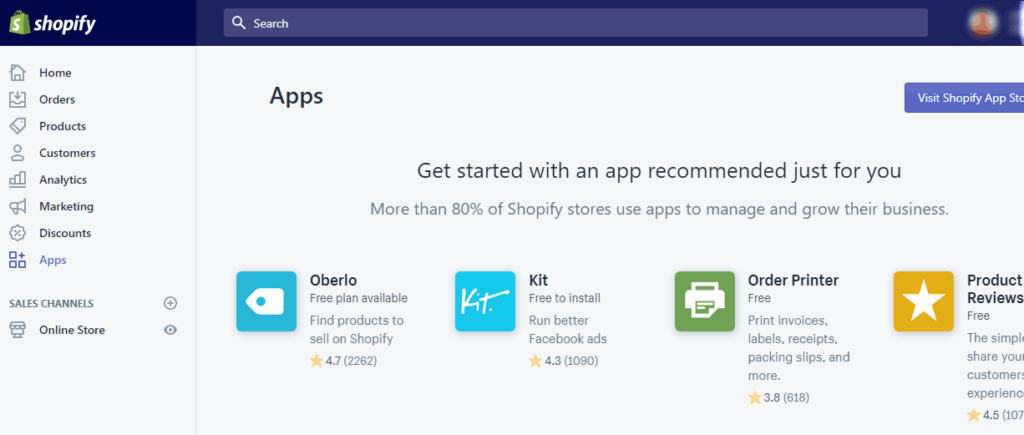
They still have the Shopify POS for basic brick and mortar shops seeking to take payments using the smartphone app. Complex shops may still use it.
They are, like everything else, downsides. The not-too-bad one is that right now they have only 10 free themes. The themes paid for vary from $100 to $180.
SEO is the major drawback they have. Low rating findings reflect one of my issues with their SEO.
They even have a rigid layout of the URL; you can’t alter parts of it. In Shopify websites I have seen several odd unstructured URLs way outside the limits of /products/, /pages/, and /collections / slug. During our study, I have found that websites utilizing Shopify have poor rankings. Shopify is really middle of the pack in terms of SEO at best.
Finally, if you aren’t using Shopify Transfers, they charge processing fees. And nobody wants them. Then again, a strong alternative is Shopify Payments.
Pros
- Quick load time illumination
- Super quick to customize
- Lots of approved partners to assist you
- 1-Selling Click
- Enables various platforms and social sales
- Wonderful themes and diverse styles
Cons
- Poorly graded in SEO in consecutive trials.
- Unable to personalize the method of checkout
- Apps will add up and become expensive,
- Need a developer for sophisticated functions
Wix

In a couple of years, Wix eCommerce has come a long way. Wix wasn’t even on my radar when I first began writing eCommerce platform reviews in 2017. I offered them a very low ranking after they were introduced to my list and will not suggest them.
Today, in the ecommerce room, Wix is a big force and they offer incredible value for solorprenuers and small ecommerce firms. In a few years, Wix’s e-commerce features have improved dramatically, now providing multi-channel connectivity, lost cart rescue, dropship and on-demand printing capabilities.

They’ve had serious problems with SEO in previous years. Few have been resolved; others also exist, such as the brief additional string to blog post URLs and product sites. That’s not ideal for SEO, especially for large e-commerce firms.
If you expand, you will need to turn because the storage capacity is 20 GB, apart from the minimal functionality, and if you work with loads of heavy digital goods or other materials, the space may not do that.

It’s friendly for newcomers. Among all the top website builders I have worked with, when building the shop, Wix beat most for on-page customer service.
In order to add cool images, features, and build the website you like, you can drag and drop items. They have more than 500 subjects, 72 of which are free. Unfortunately, even if you used their ADI, you’re stuck with the style you wanted at the time your site was released.
Pros
- Tons of free, incredible themes.
- Very easy to use and set up
- For various uses, on-page help
- Seventy-two free themes
Cons
- Trying desperately to overcome a negative name for SEO. Enhanced, but tested very badly.
- Several places were not covered
- Upselling features and modern workflow are missing
- Difficult template to completely configure
3dcart

After its public release in 2001, 3dcart has served over 22,000 client-based online companies, including PCMag. They have certain features that are realistic, such as infinite capacity and no transaction fees. You may still use their POS, and multi-channel sale is allowed.

Despite being older than they are, 3dcart does not perform as good as BigCommerce and Shopify and the cause is simple. It’s not for newcomers. But when you log into your dashboard, there is a fun onboarding video, the entire process is hard to find out; the builder is not quite visually enticing.
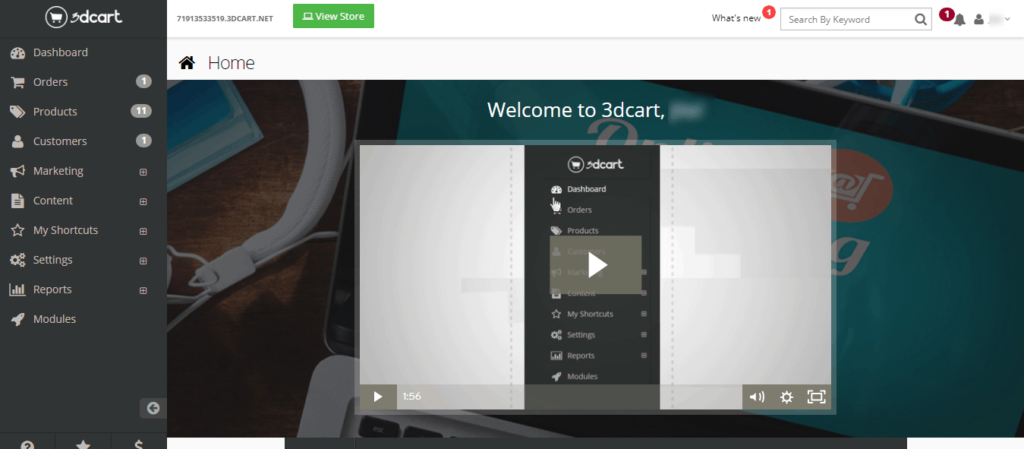
They are more industrial in the models they have, but they seem obsolete. It also takes a lot of time to configure the store to learn and get used to, except for seasoned users, since there is no drag-and – drop option. Fortunately, there’s a group of developers eager to aid with the creation of the theme and other adjustments.
I think shipping is one of their strength points; they provide sophisticated shipping solutions with no API required.
3dcart, close to BigCommerce, limits the number of purchases for each plan that you carry in. Up to 50k makes for the lowest cost of $19 a month.
The benefit is fantastic overall. Through not providing discarded cart savers as a key product, I still think it’s losing out. Shopify made a move to have it, really undercutting the rivalry. Nevertheless, it also offers more out of the box functionality than Shopify.
Pros
- Better blog feature than other eCommerce SaaS features
- Supports all the integrations you like to provide
- Good user engagement solutions for companies (email, QuickBooks, inventory, etc.)
Cons
- Templates, although seldom at the leading edge, are in step with patterns.
- Negative reviews on help for clients
- Potential upgrading concerns
- Not meant for beginners
WooCommerce

WooCommerce is the strongest unified network under one roof for operating e-commerce and partner pages. Yet actual e-commerce sites such as BigCommerce and Shopify are selling well, but not by much.
It works with WordPress to transform every website into an e-commerce shop that is usable. Extensions are now possible to add payment gateways, social networking, email marketing, sale through 1 click, and delivery.

However, the main concern is not the setup; YouTube videos will fix that. Scalability is the problem. As they get more goods and clients, most consumers have mentioned it slowing down.
It’s free for a fee. Few plugins have prices added to them, and certain WordPress themes are pricey. You do not need such extensions, though, because there are strong free themes.
If the WordPress site is common to you, so WooCommerce is a breeze for you. All you have to do is install it, select your own goods and correct your setups.
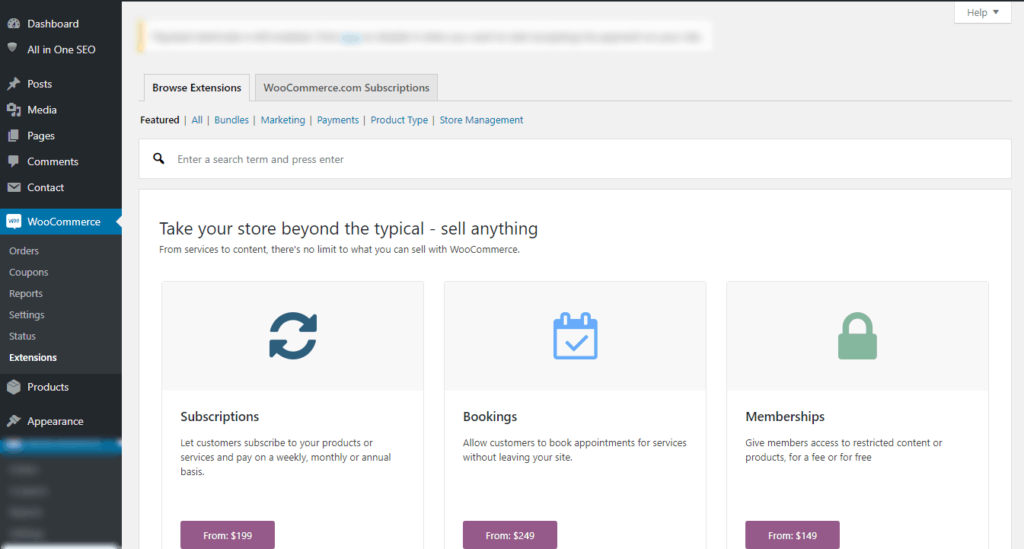
People who don’t know about WordPress are likely to struggle with the technical details. That involves hosting purchase, WordPress download, theme configuration, and plugins.
Pros
- WordPress is the perfect SEO forum for
- 1 Click App Purchases Available
- Lots of available WordPress experts
- Extremely customisable
- Many choices for ads and tons of other integrations
Cons
- Effective hosting can be expensive.
- The blame game for troubleshooting must be dealt with.
- Practically nil support
- For basic stuff, you need extensions to
Volusion

Volusion was founded in 1999, but was introduced as an e-commerce solution provider in 2002. For anyone offering tangible goods, it’s a better alternative since instant digital downloads after payment are not approved for now.
With drag and drop and in-page editing, Volusion offers a simple to use website designer. 11 free themes and a decent selection of paid themes are available. They cost around $180, and you’ll have to order an SSL certificate as well. This is a substantial added expense than several other sites pay for free.
It also doesn’t come with blogging capability, especially in this day when creating SEO with blogs is king, which is a big downer. You’ll need to use a third party like WordPress and a plugin or some means to connect the blog to your shop in order to get that.

With all of the key activity areas in the top navigation menu, the dashboard is beautifully organized. From there, you can even handle inventory and task promotion. SEO, selling on Google, eBay , Amazon, social selling, rewards, and promotions are all marketing choices.
Their rates are limited to the amount of things you will offer. There are limitations of 100 and 5000 goods respectively for the first two plans that cost $29 and $79 a month. At some point, it may shift since they used to have a bandwidth constraint, but that is no more. We are granted confidence by the relentless changes.

Help for beginners is a huge thing; you can quickly see lots of learning resources accessible from the dashboard about how to create your shop step by step with Volusion, beginning and developing your online company.
All in all, it is a good forum for the e-commerce subscription market. Dropshipping is also fine on request, but not printing. If the Amazon integration was great, I might score it higher, but it does not apply to you at all.
Pros
- Good centre for onboarding and assistance
- With Sitemaps, great versatility
- Subscription / recurring fees built-in
- Pleasant with SMB
- Dashboard well thought out
- Clear structure for inventory and promotion
Cons
- Lacks up / cross-selling capability
- Many pages were badly organized with URLs
- One of SaaS ‘s slower channels
- Many of the places that I researched looked quite dated,
- No built-in features for blogging
Prestashop

PrestaShop, which was created in 2007, is an open-source and cloud-hosted e-commerce site that offers the highest total value.
Although the word “free” makes most of us salivate immediately, the other costs you would incur with the free version can make PrestaShop Ready seem like a better choice, particularly if you don’t have the technical skills.

For the free downloaded edition, to complete your shop, you’ll have to pay for web hosting, SSL certificate, and other modules. Even, you’ll have to compensate a developer if you don’t have the high technological expertise in Javascript, CSS, and/or PHP. However, this open-code makes it easy to interact thoroughly with couriers, payment gateways, billing, warehouses, ERP, and more.
You have keys to the trial for 16 days or pay right now. It is provided with an SSL certificate.
In the admin, there are ten themes (all free) available. As the theme customizer has no drag and drop features, you can need little knowledge of HTML and CSS.
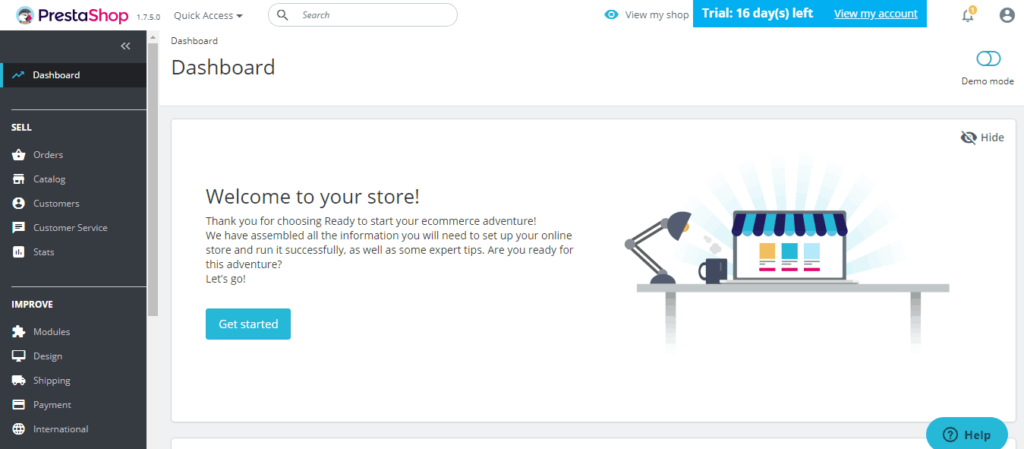
The dashboard is quick and straight ahead. An onboarding video is available, but it’s not as detailed as Shopify. However, via modules that you activate with one touch, you can accomplish most needs. This allow better SEO, Advertising, Cross-Selling, and social analytics to function.
Pros
- Tons of usable apps / integrations
- Robust SEO
- Quite scalable, open source, really versatile,
- Group wide and ready-to-help
Cons
- Slower than the other constructors
- Add-ons should be added to
- Restricted Marketing Integrations with third parties
- Developer capacity needed to tweak
- No multichannel capabilities for the edition hosted
Weebly
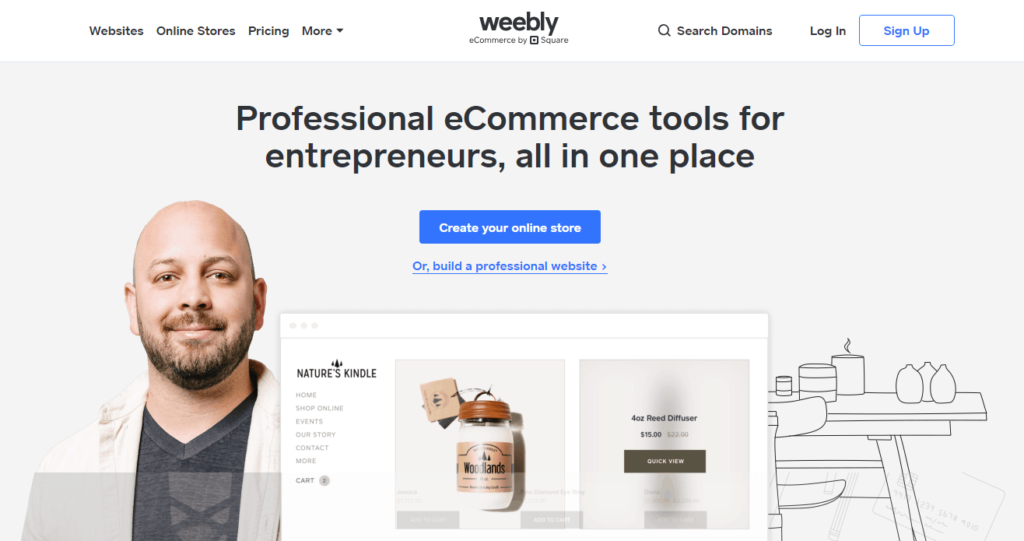
Created in 2006, Weebly is a perfect choice for those searching for a basic shop with marketing automation built in with over 40 million users. That will cost you $38 a month ($29 + $17) vs. using Shopify and Successful Campaign. But if you intend to do some sort of promotion, Weebly can outgrow you easily. If SEO is important to you, don’t use Weebly.
There hasn’t been a heavy emphasis on e-commerce before recently, and as such, you wouldn’t see some of the sophistication that other top channels have. Nevertheless, for start-up developers or anyone who do not plan to employ a developer, it remains an excellent option.

Weebly has three pricing options, and while they all endorse ecommerce, the higher two (Business and Performance) are best fit for ecommerce companies. The explanation is that there are many relevant e-commerce functions such as personalized shopping cart, discounts, and inventory tracking missing in the starter package. Even, digital products can’t be traded on it. For tangible objects, with a 3 percent processing charge, you are limited to 25 items.

To configure the design, there is a drag and drop editing function and an alternative to use HTML and CSS. There are also free themes at about $45, with paid themes. However, not all are mobile-responsive, so pick carefully.
Weebly is a website which is simple to use. To annoy you, they deliver the simple equipment you need for a practical shop without fancy accessories. Products can be uploaded in bulk and the dashboard is easy.
The mobile app that you can use to administer your organization and print shipping labels is another role worthy of notice.
Pros
- Outstanding value
- Lowest price for digital e-commerce ads
- Amazing low cost and open layouts
- Effective Software for Email
- Easy, easy-to-use dashboard
- App for handheld computers
Cons
- Charges an extra processing charge
- With SEO Sucks
- It does not appear like Amazon is on their list,
- Management of inventory is also very basic.
Squarespace

One of such apps that provides drag-and – drop is Squarespace. Established in 2003, they have modeling skills and elegant templates.
If there are a ton of things you don’t use, check them out. It’s also perfect for e-commerce sector on demand printing.
The costs are reasonably poor. You need to be on the Company website schedule, which is $18 / month when paid monthly, to begin sale. Notice that for processing costs, you would have to pay 3 percent.

For some of the e-commerce options at $26 and $40, you will avoid that. The top package enables you to get auto recovery for lost carts, sell subscriptions and gift cards, and deliver customizable discounts.
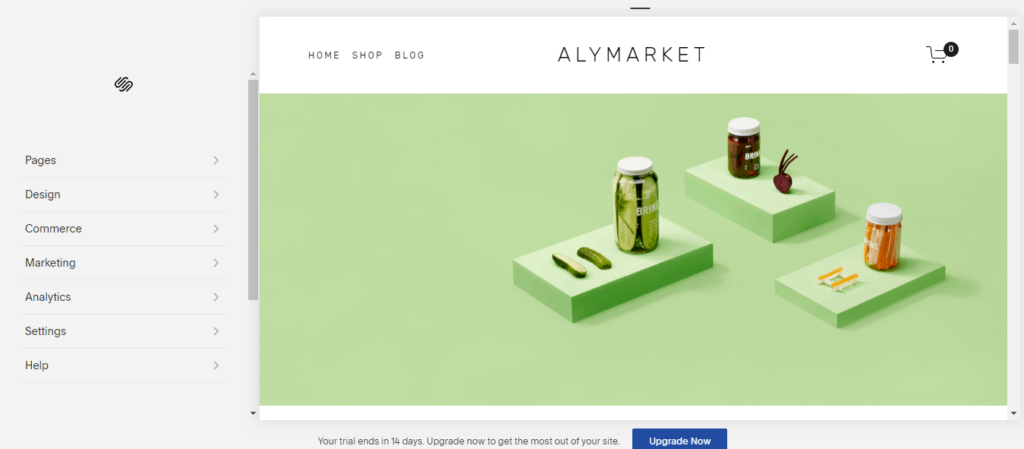
The kit comes with all the standard functionality on the side menu that you can anticipate from an e-commerce website.
However, the website design aspect is not that simple. Not as decent as Weebly’s is their drag and falling writer. Before you have the feel of it, you may have to try your hands on it a few times. You can appreciate links to ads, inventory, social sale, SEO, and analytics features after you have gotten beyond the website design process.
Squarespace incorporates ShipStation from the software portion and helps you to install Printul and ShipBob. Also accessible is the real-time measurement of shipment prices from major suppliers (UPS, FedEx, USPS).
Payment processors and third-party systems are the largest downsides. Stripe and Paypal are only sponsored by them. As with the games, with so little third-party resources, they just combine.
Pros
- Simple to Customize
- Superb for easy shops
- Amazing Prototypes
- Strong resources for SEO
- Integrates ShipStation and ShipBob with
Cons
- No dropshipping activities
- No Convergence of Marketing Automation
- No Convergence with Amazon
- It might be quicker for the amount,
- For more applications and features, no app store
Magento

The big labels including Nike, Procter & Gamble, and Cisco trust Magento. An integral aspect of the kit is coding. So, Magento is a good option if you have a developer or the budget for one and want something completely personalized and efficient. Until you have the feature-rich online store you love, you can do and reverse this.
The culture is a major part of Magento. With developers willing to work at your store for a fee or answer any of your questions free of charge, it’s huge. There’s also a marketplace where you can get plugins and themes to improve the platform ‘s capabilities.

Magento is the most freely used, although among major e-commerce firms, there is a pay standard for corporate applications. It is costly; there are tens of thousands of dollars in regular license fees. That’s big, but it’s easier on the cloud, and comes with additional functionality including automated email promotions focused on prompts and automatic cross / upsell.
Whatever you select, you can love the long list of features that can be extended. Things such as promotions, monthly fees, SEO grinding capacity, content per user change, membership subscriptions, unlimited items, and more.
Pros
- Robust and abundant in features
- Robust SEO
- 1-Selling Click
- Lots of group and consumers
- Extremely customizable, elastic and
- Flexible options of where to host the app
Cons
- Pricey subjects.
- Slowed Down Quickly
- Needs skill for growth
- Practically no help.
- To work well, it requires enough room and memory.
Best Small Business Ecommerce Site
Small companies don’t need any of the major features that drain their bank capital out. Aside from the expense, the platform’s pricing mechanism is essential, be it month-to – month or annual payments and other fees.
We have tested scalability in our research. This looks at the attributes that help grow the website. When your profits start to ramp up, you’ll want your operations to grow smoothly. That means multi-channel sales, sales on other channels and even nations. When you scale, you might even need apps created only for your company.
The Platforms Suggested
- BigCommerce
- WooCommerce
- Wix
Best Startups & Newcomers Ecommerce Network
The demand for e-commerce is booming, and internet-savvy consumers tend to use an online shop to interact with clients. Starting an e-commerce company often involves coming face to face with any latest development that seems to be a fundamental need and e-commerce sites have strong aspirations.
Startups will require a forum, including small companies, that helps them to expand quickly and smash through the already established citizens. Your platform needs to be able to accommodate what you initially put in while giving space for further expansion, because you could be entering the business as a large store owner.
Our tests evaluated the functionality that startups required. SEO, strong UX architecture, marketing inputs, and the potential to sell on different channels such as smartphone applications and social networks are included.
Look at the output of each platform dependent upon these indicators.
Simplicity of Usage
Ecommerce developers should be willing to open and operate a shop on their own for the first time without needing to call a developer for any last item. So we gave extra weight to the opportunity to openly set up and operate the store code.

BigCommerce and Shopify are at par in ease of use ratings, from our study. Before you can use them, you don’t have to be the leader in Web Dev because there’s a lot of help. Come close, 3dcart and Wix.
But Wix is not the best choice for e-commerce, and WooCommerce kills all-in-one, particularly for cost optimization and SEO development, for beginners / startups.
The Platforms Suggested
- BigCommerce
- WooCommerce
- Shopify
SEO ‘s Strongest Ecommerce Site
SEO is pivotal. If network visitors do not find your website with a search engine, you would have a tough time operating an e-commerce shop. To improve your website, several platforms offer several SEO resources. Notwithstanding, some are stronger than others.
In our research , we focused the best SEO e-commerce platforms on website load time, mobile and desktop speed, SEO, and average organic traffic utilizing each platform from top online stores.

SEO Output for Platform
SEO is dead. “-People who have no idea how to do SEO.
May we tell you exactly how sick it feels to say it, and how false it is, once and for all?
When I rant, I ‘m sorry, but you need to know your SEO. Keyword stuffing and material written for machines and spiders has never been a brilliant move, and it’s definitely penalized and can be disciplined by everyone who does it.
Weak SEO is gone. Should be that.
In the other side, strong SEO is both alive and well. The best SEO methods will rocket you to the peak of the prized search results of Google, and on Yahoo! and Bing, too, earn mates. You’ll create more organic traffic, save you cash on leads. SEO is a key component of web design and efficiency, and your e-commerce company has plenty of rating requirements to remember.
It is a successful first step to make it easier for humans and robotics to access, and that involves having the correct URL frameworks. Web promotion and truthful backlinking with white hats are also wise. Nice SEO, that is.
Pleasant URLs for SEO
URLs are exceptionally significant. Do NOT forget the framework of strong URLs.
It’s not something you can make up for by excellent content and backlinks. And though we dislike raising fingers and throwing up negative examples, we beg you.
Don’t make your URLs ever look like this:
HTTP / purplesagetea.com / epages/472f26ef-dbcc-482e-8f37-4e8a0b5ede3c.sf / fr US/? ObjectPath=/Shops/472f26ef-dbcc-482e-8f37-4e8a0b5ede3c (via 1&1 / ePages)/Categories / Category 3
Nice range of teas, but we’re guessing their shop isn’t making anywhere near what it should be with the sluggish load time and the frustrating URL.
They neglect strong technological SEO features.
Search engines like to make it for the end user clear and convenient. Bulky, immense URLs are Seldom easy to use. They’re also not good for your company. An significant ranking element is fast, valid URLs. Excellent for accessibility.
For SEO, WooCommerce is the strongest by far. Magento still doesn’t do poorly. That’s because anything can be personalized and the capabilities can be expanded.
I ‘d tell from our numbers, stay away from Shopify if your main goal is SEO. They need a lot of change though. Where WooCommerce scored 5, they earned 2.5 and the average is 3.7. It is not shocking that Shopify only moves half of that across a line, where the average organic traffic score is 20,346, but Woo is at 70 +.
Loading Period
Load time is a fairly clear measure of how fast your site is. Simply placed, it’s the indicator of how long it takes a page (or pages) on your web to completely load. A slow site is an e-commerce killer-potential clients run away from slow pages, and any second you gain in site loading speed turns directly into revenue received, as we discussed earlier.
In electronic commerce, pace is currency. It costs you every second that your site takes to launch. A perfect offer.
Most users want pages to be loaded in 3 seconds or less, according to Akamai research. For the top 500 e-commerce pages, the median load period is 10 seconds.
The load time for typical e-commerce websites is 3.2 seconds, according to our results, but the framework you choose makes a huge difference. WooCommerce pages, for instance, appear to load in 3.4 seconds, whereas 3DCART sites tend to load in less than 3 seconds.
Moreover, a 1-second load time change is equal to a 7 percent rise in conversions. Wouldn’t this have been nice?
You might customize it for pace if you’re operating a self-hosted site, but again, it takes time and effort. It doesn’t concern any self-hosted sites; the typical Magento server loads in 5 seconds. Forget the sluggish platform to receive some credit card purchases.
Price may be the issue. It’s not inexpensive to optimize for speed, and ironically, it may take a lot of time.
A hidden tool in your e-commerce arsenal is an out-of-the-box solution promising great loading speed. Don’t neglect this metric ‘s meaning.
Speed efficiency is so important; to assess how well a site operates, we gathered numerous types of data (from 2000 ecommerce website domains).
PageSpeed of Google
The PageSpeed Score from Google is focused on many variables that rate the pace and usability of your website. You’ll note low smartphone speed scores all over the board. 51.5/100 is the average ranking.
The smartphone pace crunch is really beginning to be felt by advertisers and developers. Mobile consumers want their mobile devices to launch websites quicker than their desktop devices. In order to make mobile pages load quicker, businesses like Google are working on initiatives like AMP.
Google PageSpeed is now measuring desktop speed. Check out the details on the success of different platforms below.
The Platforms Suggested
- WooCommerce
- BigCommerce
- Magento
Best Dropshipping Ecommerce Network
You’re not in charge of several items in dropshipping; product consistency and returns could be a obstacle. Often, if you are trying to dominate the supply of that commodity, there are technological stones that you need to transfer to avoid your orders leaving as quickly as they reach your e-commerce framework.
We looked at these attributes while assessing:
Capacity to sync with the inventory of vendors
Help of several plugins for dropshipping
Automation of multiple vendors or SKUs for the same commodity
Tracking the order from both your hand and the end user
Free / paid incorporation for dropshipping
The Platforms Suggested
- Shopify
- BigCommerce
Best Central Brick and Mortar Ecommerce Site
Many local brick and mortar stores only need a small basic store. For starters, you don’t need a feature-rich platform if you’re a local bakery trying to take payments on your website. In this situation, we skipped multichannel or campaign automation because, let’s be frank, you don’t need it.
Don’t let dishonest developers fool you into paying for that, because a lot of it happens. So, we looked at the potential to develop a website and quickly integrate a payment gateway. No publicity or shopping cart rescue right here.
The Platforms Suggested
- Shopify
- Wix
- Weebly
Best Big Market E-commerce Site
You would want full control and server autonomy if you operate a big e-commerce company. Under any scenario, you’re looking at purchasing from a web hosting provider a dedicated server or VPS and setting up your website there. As such, SAAS may not please you, like Shopify.
However, if you’d rather set it up and not mess about the technicalities of web hosting, then it might be a website like BigCommerce.
You would require a network that allows you the consistency to attach apps, lets you minimize mistakes, and easily combines the warehouse management and other inventory systems, because you have orders varying from hundreds or thousands of times a week. Platforms that support numerous currencies and stores, integration with Google services, and 3PLs have also been considered.
The Platforms Suggested
- BigCommerce
- 3dcart
- Magento
Design Requirements For Ecommerce Sites
Your website should have a rich and seamless interface that will inspire consumers to visit your website, make them linger and enable them to shop. The architecture is one key area that begins. Online retailers way too frequently go out with complex templates that do little other but bog down the load time and inconvenience tourists. Any template you want should be built to impress prospective clients.
The same goes for the method of navigation and checkout.

There are things you can watch out for:
Personalization
You’ll need to change several functionality on your e-commerce website to get the latest. Therefore, the Shopify checkout process is restrictive. Except when you pay for Shopify Plus, the adjustments you will make to the checkout pages are small. Yeah, Shopify Plus has its advantages, but if you don’t need any of them, it may be utter crazy to spend at least $2000 per month just for the sake of the checkout page.
If you think of WooCommerce, because of children’s themes, you can customize almost all. This is one area that is handled right with self-hosted platforms.
Elementor is the bonus tip I’ll leave here. When coupled with the plugin for BigCommerce or WooCommerce, the drag and drop builder plugin is quite strong. You can build advanced pricing tables, price lists and widgets for items, configure your checkout screen, monitor your order, and enhance the website’s mobile view without coding. Another plus is that it is ready for translation; the store will read to someone in Mexico and French to someone in France in Spanish, bringing marketing to another stage.
Range of Theme
The frontline for any tuning you may do is your theme. If you’re a coding novice or your framework doesn’t allow any re-coding for developers, you need to pick a theme that suits your requirements and matches your clients. Look out for the one that is perfect for your niche and what other ecommerce websites pick while selecting the correct style.
Costs are another matter. Shopify and BigCommerce are limited to 9 and 7, respectively, but you can get a wide range of free WordPress themes. You’re going to have to compensate for the other awesome guys you would choose. You should reach out to a professional to tailor a theme for you or build one from scratch if you are interested in investing more for the best.
Mobile Efficiency for Ecommerce
What are cell phones? Rather than a fad, mobile technology is the hope of an e-commerce retailer. For both e-retailers, mobile-friendly pages are a must have, and for good cause.
- 66 percent of the time spent on online ecommerce is achieved by mobile devices
- To support them make a purchase choice, 82 percent of mobile users switch to their smartphones.
Customers want the design of mobile-friendly e-commerce websites, and the trend reveals that mobile commerce is growing 300% faster than e-commerce, which ensures that the website must also have a responsive design.
You need to ensure sure the web website is simple to update in order to get the best out of mobile site architecture. To see what performs and what doesn’t, look at live pages.
Repeatedly and on different devices, evaluate your website and don’t forget to hold your smartphone package strong on the graphics and with a font big enough for anyone to use, not to mention simple and intuitive navigation.
With your architecture and UX loading results, take a true mobile-first approach.
WooCommerce, Shopify, and Weebly carry the crown in this respect. Both of these are at or above the 94% median score.
Mobile View of Consumers
Around 40 percent of the overall sales were made on a mobile during the 2018 holiday season. And almost half the e-commerce stores’ traffic comes from mobile devices. This is against the one-fourth registered in 2017. Mobile e-commerce is growing so rapidly that you need to worry not just about responsive architecture, but also about the best interface imaginable. The Google Mobile User Interface Ranking is one way to get about this.
The Mobile User Interface ranking from Google gives a perfect idea about how much the website would frustrate mobile users … or not. This score attempts to imitate how a real person communicates with the page.
Five main things to remember for the mobile user experience are, according to a report on Moz:
- Configuration of Viewport
- Legibility of Font
- The usage of modules that are incompatible
- Viewport material
- Links’ scale and proximity
All platforms have performed good here except Wix. It’s more about your work, however.
Recommended Platforms 2020
There is no ideal forum for e-commerce, but I have narrowed down the top options.
Choosing the right site creator for e-commerce is really dependent on your needs. BigCommerce was by far the strongest overall forum for any market concept and does well for SEO. We want to suggest that you recognize a couple as front-runners.
WooCommerce is keeping up in terms of functionality and applications of industry leaders like Shopify. Great for e-commerce platforms with a private / white label. Awesome for ads for affiliates. And if you want to operate a private label & affiliate marketing combo platform, the best choice is.
The strongest app for dropshipping, like print on demand, is Shopify.
Wix fits with shops that are plain. I’d choose Wix over Squarespace or Weebly if I was operating a small bakery that takes a few online orders. In a few years, Wix has come a long way and is well priced for soloprenuers or tiny shops.
If you think Magento, it’s worth a glance at X-Cart. If you have Dev capital, it is one of the strongest free e-commerce sites. Plus, in recent years , a lot of investment has been made in growing the product and brand.
The bulk of e-commerce sites do a fine job. Before subscribing to, there are a few that we will advise you to think twice, including Magento, Accessible Cart, Jigoshop, ePages (1&1), WP Ecommerce, CoreCommerce, and Major Cartel. At comparable price points, there are far better alternatives available. Even, these platforms are used and loved by many people.







